Zhicheng Yang
Understanding GUI Agent Localization Biases through Logit Sharpness
Jun 18, 2025Abstract:Multimodal large language models (MLLMs) have enabled GUI agents to interact with operating systems by grounding language into spatial actions. Despite their promising performance, these models frequently exhibit hallucinations-systematic localization errors that compromise reliability. We propose a fine-grained evaluation framework that categorizes model predictions into four distinct types, revealing nuanced failure modes beyond traditional accuracy metrics. To better quantify model uncertainty, we introduce the Peak Sharpness Score (PSS), a metric that evaluates the alignment between semantic continuity and logits distribution in coordinate prediction. Building on this insight, we further propose Context-Aware Cropping, a training-free technique that improves model performance by adaptively refining input context. Extensive experiments demonstrate that our framework and methods provide actionable insights and enhance the interpretability and robustness of GUI agent behavior.
TreeRPO: Tree Relative Policy Optimization
Jun 05, 2025Abstract:Large Language Models (LLMs) have shown remarkable reasoning capabilities through Reinforcement Learning with Verifiable Rewards (RLVR) methods. However, a key limitation of existing approaches is that rewards defined at the full trajectory level provide insufficient guidance for optimizing the intermediate steps of a reasoning process. To address this, we introduce \textbf{\name}, a novel method that estimates the mathematical expectations of rewards at various reasoning steps using tree sampling. Unlike prior methods that rely on a separate step reward model, \name directly estimates these rewards through this sampling process. Building on the group-relative reward training mechanism of GRPO, \name innovatively computes rewards based on step-level groups generated during tree sampling. This advancement allows \name to produce fine-grained and dense reward signals, significantly enhancing the learning process and overall performance of LLMs. Experimental results demonstrate that our \name algorithm substantially improves the average Pass@1 accuracy of Qwen-2.5-Math on test benchmarks, increasing it from 19.0\% to 35.5\%. Furthermore, \name significantly outperforms GRPO by 2.9\% in performance while simultaneously reducing the average response length by 18.1\%, showcasing its effectiveness and efficiency. Our code will be available at \href{https://github.com/yangzhch6/TreeRPO}{https://github.com/yangzhch6/TreeRPO}.
Are LLMs Really Not Knowledgable? Mining the Submerged Knowledge in LLMs' Memory
Dec 30, 2024Abstract:Large language models (LLMs) have shown promise as potential knowledge bases, yet they often struggle with question-answering tasks and are prone to hallucinations. While previous research attributes these issues to knowledge gaps in the model's parameters, our investigation reveals a different phenomenon: LLMs often retain correct knowledge even when generating incorrect answers. Through analysis of model's internal representations, we find that correct answers frequently appear among high-probability tokens despite not being selected as final outputs. Based on this observation, we introduce Hits@k, a new metric to assess knowledge retention independent of expression accuracy. Our extensive experiments demonstrate that LLMs store significantly more knowledge than their QA performance suggests. Building on these findings, we develop SkipUnsure, a method to improve answer accuracy by leveraging detected but unexpressed knowledge. Experiments on both open-domain and specific-domain datasets show consistent improvements, with accuracy gains of up to 11.8% on DBPedia and 6.3% on IMDB, without requiring model retraining.
CityWalker: Learning Embodied Urban Navigation from Web-Scale Videos
Nov 26, 2024Abstract:Navigating dynamic urban environments presents significant challenges for embodied agents, requiring advanced spatial reasoning and adherence to common-sense norms. Despite progress, existing visual navigation methods struggle in map-free or off-street settings, limiting the deployment of autonomous agents like last-mile delivery robots. To overcome these obstacles, we propose a scalable, data-driven approach for human-like urban navigation by training agents on thousands of hours of in-the-wild city walking and driving videos sourced from the web. We introduce a simple and scalable data processing pipeline that extracts action supervision from these videos, enabling large-scale imitation learning without costly annotations. Our model learns sophisticated navigation policies to handle diverse challenges and critical scenarios. Experimental results show that training on large-scale, diverse datasets significantly enhances navigation performance, surpassing current methods. This work shows the potential of using abundant online video data to develop robust navigation policies for embodied agents in dynamic urban settings. https://ai4ce.github.io/CityWalker/
ZALM3: Zero-Shot Enhancement of Vision-Language Alignment via In-Context Information in Multi-Turn Multimodal Medical Dialogue
Sep 26, 2024
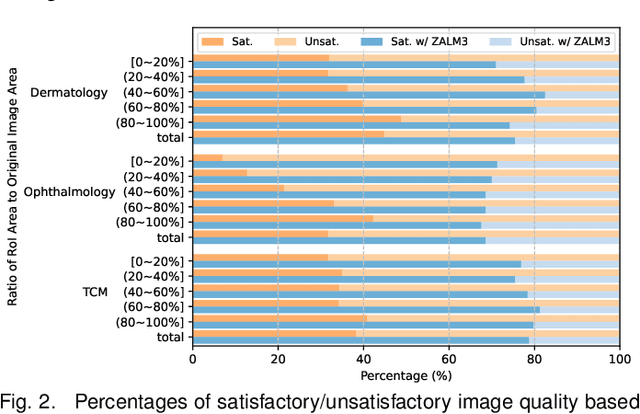
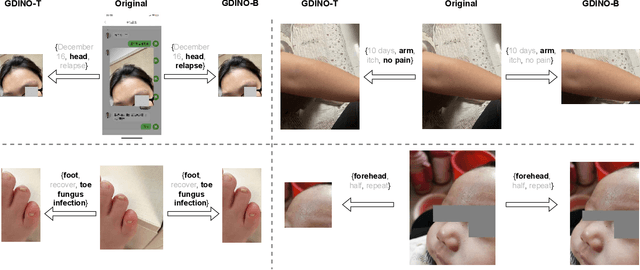
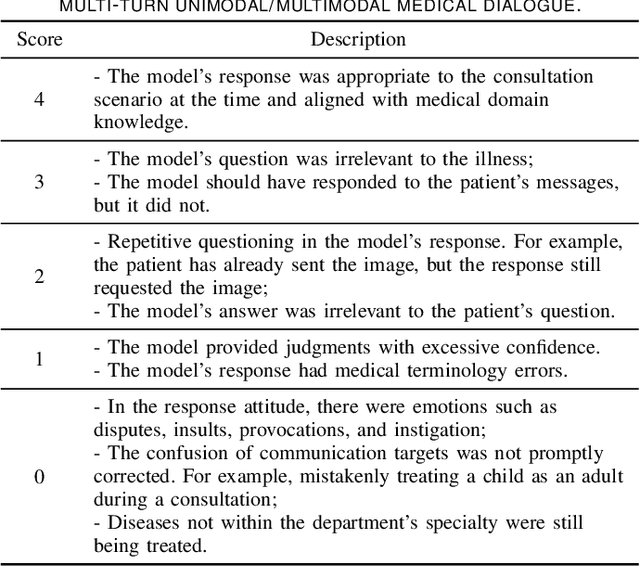
Abstract:The rocketing prosperity of large language models (LLMs) in recent years has boosted the prevalence of vision-language models (VLMs) in the medical sector. In our online medical consultation scenario, a doctor responds to the texts and images provided by a patient in multiple rounds to diagnose her/his health condition, forming a multi-turn multimodal medical dialogue format. Unlike high-quality images captured by professional equipment in traditional medical visual question answering (Med-VQA), the images in our case are taken by patients' mobile phones. These images have poor quality control, with issues such as excessive background elements and the lesion area being significantly off-center, leading to degradation of vision-language alignment in the model training phase. In this paper, we propose ZALM3, a Zero-shot strategy to improve vision-language ALignment in Multi-turn Multimodal Medical dialogue. Since we observe that the preceding text conversations before an image can infer the regions of interest (RoIs) in the image, ZALM3 employs an LLM to summarize the keywords from the preceding context and a visual grounding model to extract the RoIs. The updated images eliminate unnecessary background noise and provide more effective vision-language alignment. To better evaluate our proposed method, we design a new subjective assessment metric for multi-turn unimodal/multimodal medical dialogue to provide a fine-grained performance comparison. Our experiments across three different clinical departments remarkably demonstrate the efficacy of ZALM3 with statistical significance.
Benchmarking LLMs for Optimization Modeling and Enhancing Reasoning via Reverse Socratic Synthesis
Jul 13, 2024



Abstract:Large language models (LLMs) have exhibited their problem-solving ability in mathematical reasoning. Solving realistic optimization (OPT) problems in industrial application scenarios requires advanced and applied math ability. However, current OPT benchmarks that merely solve linear programming are far from complex realistic situations. In this work, we propose E-OPT, a benchmark for end-to-end optimization problem-solving with human-readable inputs and outputs. E-OPT contains rich optimization problems, including linear/nonlinear programming with/without table data, which can comprehensively evaluate LLMs' solving ability. In our benchmark, LLMs are required to correctly understand the problem in E-OPT and call code solver to get precise numerical answers. Furthermore, to alleviate the data scarcity for optimization problems, and to bridge the gap between open-source LLMs on a small scale (e.g., Llama-2-7b and Llama-3-8b) and closed-source LLMs (e.g., GPT-4), we further propose a novel data synthesis method namely ReSocratic. Unlike general data synthesis methods that proceed from questions to answers, ReSocratic first incrementally synthesizes optimization scenarios with mathematical formulations step by step and then back-translates the generated scenarios into questions. In such a way, we construct the ReSocratic-29k dataset from a small seed sample pool with the powerful open-source large model DeepSeek-V2. To demonstrate the effectiveness of ReSocratic, we conduct supervised fine-tuning with ReSocratic-29k on multiple open-source models. The results show that Llama3-8b is significantly improved from 13.6% to 51.7% on E-OPT, while DeepSeek-V2 reaches 61.0%, approaching 65.5% of GPT-4.
Process-Driven Autoformalization in Lean 4
Jun 04, 2024



Abstract:Autoformalization, the conversion of natural language mathematics into formal languages, offers significant potential for advancing mathematical reasoning. However, existing efforts are limited to formal languages with substantial online corpora and struggle to keep pace with rapidly evolving languages like Lean 4. To bridge this gap, we propose a new benchmark \textbf{Form}alization for \textbf{L}ean~\textbf{4} (\textbf{\name}) designed to evaluate the autoformalization capabilities of large language models (LLMs). This benchmark encompasses a comprehensive assessment of questions, answers, formal statements, and proofs. Additionally, we introduce a \textbf{P}rocess-\textbf{S}upervised \textbf{V}erifier (\textbf{PSV}) model that leverages the precise feedback from Lean 4 compilers to enhance autoformalization. Our experiments demonstrate that the PSV method improves autoformalization, enabling higher accuracy using less filtered training data. Furthermore, when fine-tuned with data containing detailed process information, PSV can leverage the data more effectively, leading to more significant improvements in autoformalization for Lean 4. Our dataset and code are available at \url{https://github.com/rookie-joe/PDA}.
FedSAC: Dynamic Submodel Allocation for Collaborative Fairness in Federated Learning
May 28, 2024Abstract:Collaborative fairness stands as an essential element in federated learning to encourage client participation by equitably distributing rewards based on individual contributions. Existing methods primarily focus on adjusting gradient allocations among clients to achieve collaborative fairness. However, they frequently overlook crucial factors such as maintaining consistency across local models and catering to the diverse requirements of high-contributing clients. This oversight inevitably decreases both fairness and model accuracy in practice. To address these issues, we propose FedSAC, a novel Federated learning framework with dynamic Submodel Allocation for Collaborative fairness, backed by a theoretical convergence guarantee. First, we present the concept of "bounded collaborative fairness (BCF)", which ensures fairness by tailoring rewards to individual clients based on their contributions. Second, to implement the BCF, we design a submodel allocation module with a theoretical guarantee of fairness. This module incentivizes high-contributing clients with high-performance submodels containing a diverse range of crucial neurons, thereby preserving consistency across local models. Third, we further develop a dynamic aggregation module to adaptively aggregate submodels, ensuring the equitable treatment of low-frequency neurons and consequently enhancing overall model accuracy. Extensive experiments conducted on three public benchmarks demonstrate that FedSAC outperforms all baseline methods in both fairness and model accuracy. We see this work as a significant step towards incentivizing broader client participation in federated learning. The source code is available at https://github.com/wangzihuixmu/FedSAC.
Proving Theorems Recursively
May 23, 2024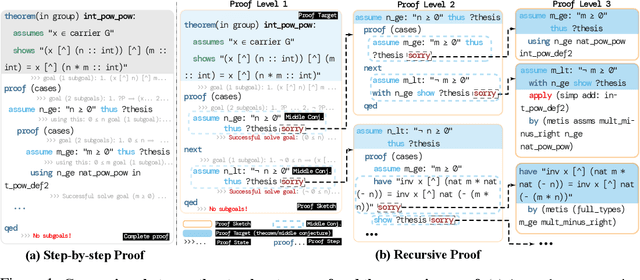

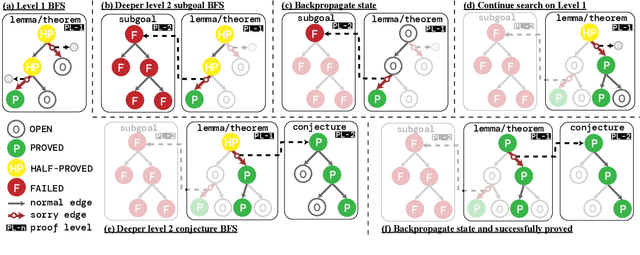
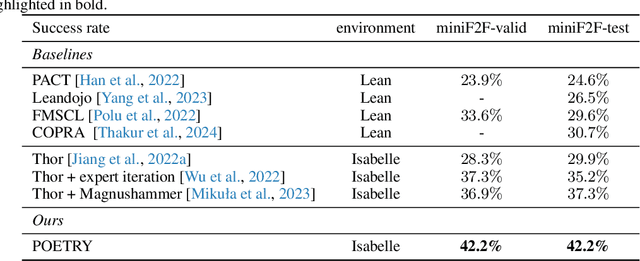
Abstract:Recent advances in automated theorem proving leverages language models to explore expanded search spaces by step-by-step proof generation. However, such approaches are usually based on short-sighted heuristics (e.g., log probability or value function scores) that potentially lead to suboptimal or even distracting subgoals, preventing us from finding longer proofs. To address this challenge, we propose POETRY (PrOvE Theorems RecursivelY), which proves theorems in a recursive, level-by-level manner in the Isabelle theorem prover. Unlike previous step-by-step methods, POETRY searches for a verifiable sketch of the proof at each level and focuses on solving the current level's theorem or conjecture. Detailed proofs of intermediate conjectures within the sketch are temporarily replaced by a placeholder tactic called sorry, deferring their proofs to subsequent levels. This approach allows the theorem to be tackled incrementally by outlining the overall theorem at the first level and then solving the intermediate conjectures at deeper levels. Experiments are conducted on the miniF2F and PISA datasets and significant performance gains are observed in our POETRY approach over state-of-the-art methods. POETRY on miniF2F achieves an average proving success rate improvement of 5.1%. Moreover, we observe a substantial increase in the maximum proof length found by POETRY, from 10 to 26.
ATG: Benchmarking Automated Theorem Generation for Generative Language Models
May 05, 2024Abstract:Humans can develop new theorems to explore broader and more complex mathematical results. While current generative language models (LMs) have achieved significant improvement in automatically proving theorems, their ability to generate new or reusable theorems is still under-explored. Without the new theorems, current LMs struggle to prove harder theorems that are distant from the given hypotheses with the exponentially growing search space. Therefore, this paper proposes an Automated Theorem Generation (ATG) benchmark that evaluates whether an agent can automatically generate valuable (and possibly brand new) theorems that are applicable for downstream theorem proving as reusable knowledge. Specifically, we construct the ATG benchmark by splitting the Metamath library into three sets: axioms, library, and problem based on their proving depth. We conduct extensive experiments to investigate whether current LMs can generate theorems in the library and benefit the problem theorems proving. The results demonstrate that high-quality ATG data facilitates models' performances on downstream ATP. However, there is still room for current LMs to develop better ATG and generate more advanced and human-like theorems. We hope the new ATG challenge can shed some light on advanced complex theorem proving.
 Add to Chrome
Add to Chrome Add to Firefox
Add to Firefox Add to Edge
Add to Edge